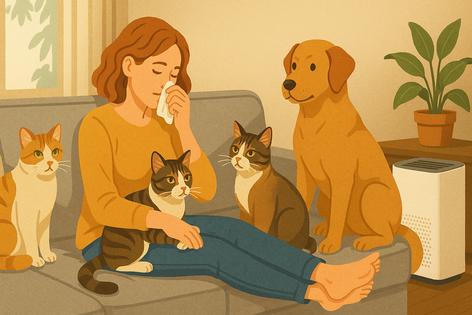Living With Allergies When You Have a Cat or Dog
Published in Cats & Dogs News
For some, the bond with a pet is instant and unconditional. For others, it comes with watery eyes, sneezes, and a box of tissues. Pet allergies are among the most common allergic conditions in the world, affecting an estimated 10 to 20 percent of the population. Yet despite the discomfort, most people choose to keep their animals. Why? Because life with a cat or dog, for many, is worth the extra effort.
Understanding Pet Allergies
The culprit isn’t fur itself but proteins—most notably Fel d 1 in cats and Can f 1 in dogs—that collect on dander, saliva and urine. When pets groom, shed, or simply move around the house, those proteins become airborne. They cling stubbornly to fabrics, carpets and even walls, making them difficult to eliminate.
Cats, in particular, present a challenge. Their allergen is sticky and lightweight, spreading far beyond the home. Dog allergens vary by breed, size and even individual, meaning one dog may trigger reactions while another does not.
Medical Options
Doctors often begin with antihistamines or nasal sprays to relieve symptoms. For more persistent cases, allergy shots—immunotherapy—can gradually desensitize the immune system, teaching it to tolerate the allergen. This process may take months or years but can provide lasting relief.
Emerging treatments, including under-the-tongue drops and biologics that target specific immune responses, are offering hope for pet lovers with severe allergies. While not cures, these therapies represent a growing recognition that many people would rather treat their symptoms than part with their companions.
Cleaning and Home Management
Home management plays a crucial role. Regular vacuuming with HEPA filters, frequent washing of bedding, and keeping pets off upholstered furniture can reduce allergen buildup. Air purifiers, especially in bedrooms, help create “safe zones” where people can rest without constant exposure.
Designating certain rooms as pet-free may seem strict, but for many, it creates a balance between sharing space with pets and maintaining health. Even small steps, like using washable throw blankets or keeping windows open when possible, can make an impact.
Bathing and Grooming
Bathing pets once or twice a week can reduce allergens, though cats rarely cooperate. Alternatives include wiping down fur with damp cloths or pet-safe wipes. Regular grooming—ideally outdoors or at a salon—can also keep dander in check.
For dogs, grooming has the added benefit of removing outdoor allergens like pollen, which can compound problems for sensitive owners. Groomers increasingly market themselves as partners in allergy management, offering de-shedding treatments and specialized shampoos.
The Human Side of the Story
Behind the science and strategies lies the emotional reality: many pet owners endure their allergies because the bond is simply too strong. They accept itchy eyes or daily medication as part of the cost of companionship. Studies have even shown that the presence of pets can reduce stress, lower blood pressure and improve mental health—benefits that often outweigh the discomfort of allergic reactions.
Children raised with pets sometimes develop stronger immune systems and may even be less likely to develop allergies later in life. The paradox is striking: pets can both trigger allergies and, in some cases, help prevent them.
Finding Balance
Living with allergies and pets is a negotiation, not a surrender. For some, it means more cleaning and medical appointments. For others, it involves trial and error—finding which products, treatments, and routines work best. The path is not the same for everyone, but the destination is shared: a home where health and companionship coexist.
Because in the end, the wag of a dog’s tail or the soft purr of a cat is more than worth a sneeze or two. It is a reminder that love, in its many forms, often asks for patience and compromise—and rewards us with joy.
========
The article was created, in part, utilizing AI tools.









Comments